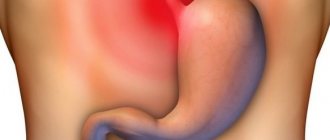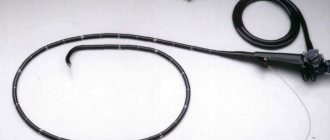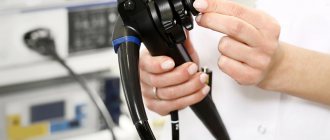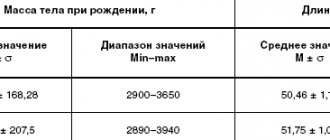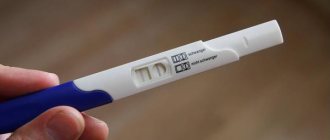My stomach hurts. After an examination, gastroscopy and tests, the doctor prescribed a whole list of medications, including an antibiotic, vitamins and De Nol tablets. Everything is clear with antibiotics and vitamins.
But “De Nol” caused some confusion. Is this drug another antibiotic? What is the point of prescribing 2 drugs of the same group? And is it worth feeding yourself with additional medicine?
Composition and pharmacological properties
The main and only active ingredient in De-Nol is colloidal bismuth subcitrate.
This substance has essential properties that help it be successfully used in the treatment of ulcers. Thanks to its film-forming effect, De-Nol protects the injured mucous membrane of the digestive tract from the aggressive effects of acids and enzymes. By causing increased local production of prostaglandins, the drug helps reduce the acidity of food juice, which makes it less aggressive and traumatic.
The medicine has a bactericidal effect against Helicobacter pylor, which is a provoking factor for ulcers.
How to replace "De Nol"?
A side effect of taking the drug may be nausea.
All medications are divided into complete analogues with the same active substance, and drugs that have a similar effect, but with a different composition. Bismuth-containing analogues of “De Nol”:
- Gastronorm – can be used from 14 years of age. Indications for use and side effects are the same as for De Nol. Take 1 tablet 4 times a day.
- Ventrisol - indications and dosage are the same as De Nol and Gstronorm.
- Novobismol.
- Bisnol.
- Pilocid.
- Trimo.
These are complete analogues of the expensive “De Nola”. They have a similar effect. Recommendations for use: 1 tablet half an hour before meals, 4 tablets at night before bedtime. Drink with water. Milk, tea, and fruit juices reduce the activity of the drugs. Analogs of "De Nol" that do not contain bismuth, but have a similar effect:
- Venter – composed of sucrose sulfate and aluminum hydroxide. Available in sachets and tablets. Dosage – 1 tablet or sachet 4 times a day. Dissolve the powder in a sufficient volume of water. Take half an hour before meals.
- Amagel is the active ingredient aluminum hydroxide. Has an enveloping effect on the gastric mucosa. Does not show antibacterial activity.
- Ranitidine - inhibits the release of hydrochloric acid, thereby promoting the healing of ulcers in various parts of the gastrointestinal tract.
- Gastal - active ingredients magnesium oxide and hydroxide, aluminum hydroxide. Reduces acidity, which promotes the regeneration of the gastric mucosa. Does not have an antibacterial effect on Helicobacter pylori.
- Nolpaza - similar to Gastal.
Any replacement of medications must be carried out as prescribed by a doctor. It is better not to show independence.
Why might the stool be black?
But let's return to bismuth derivatives and try to find out why De-Nol's stool is black. In fact, during therapy with De-Nol, stool may turn not only black. Dark brown and greenish tints may be present. It depends on the body's reaction. Once in the stomach, bismuth subcitrate combines with other substances and forms a new, completely harmless component - bismuth sulfide. This is what turns the excrement black.
However, it is very important to understand that De-Nol is not the only one that turns stools black. Eating certain foods, berries, and fruits (such as mulberries) can also cause dark-colored stool.
Blood impurities, in the following diseases, create the effect of black stool:
- neoplasms in the rectal area;
- ulcerative colitis, nonspecific type;
- proctitis;
- Crohn's disease;
- vascular pathologies of the gastrointestinal tract;
- severe liver dysfunction.
If the stool turns black without using medications containing iron and bismuth, you should consult a doctor for advice and undergo an appropriate examination.
Why is there black stool after De-nol?
The reason for the change lies in the composition of the medicine: when it enters the body, a specific compound is formed - bismuth sulfide, which gives color to the feces, including black.
Darkening of stool is not a cause for concern. The same applies to darkening of the tongue. This reaction is a consequence of the effect of tripotassium bismuth dicitrate on the mucous membranes.
In addition to black stool, the patient may experience other symptoms:
- pallor, increased fatigue and weakness;
- vomiting "coffee grounds";
- decreased blood pressure, increased heart rate;
- pain in the stomach;
- nausea, fainting.
If such symptoms appear, it is recommended to call an ambulance team, which will stabilize the patient’s condition and hospitalize him in the surgical or gastroenterological department. During the treatment of exacerbation of chronic, especially erosive, gastritis, it is prohibited to take aspirin and other NSAIDs (ibuprofen, nimesulide) orally unless absolutely necessary. Their use can worsen the condition and cause bleeding.
The reason for the change lies in the composition of the drug: when it enters the body, a specific compound is formed - bismuth sulfide, which gives color to the stool, including black
Side effects
Despite the fact that De-Nol is well tolerated by patients, sometimes side effects may occur, which manifest themselves as follows:
- The color of stool when using the drug De-Nol becomes black or dark.
- there is a feeling of nausea or vomiting;
- constipation or frequent urge to defecate develops;
- allergic reactions in the form of rash reactions and itching.
Most often, these manifestations are not dangerous and disappear after cessation of therapy . However, in any situation, they should be reported to your doctor.
A fairly large number of patients after De-Nol have black stool, which is a normal reaction and does not require any treatment. However, it is very important to find out whether it is the staining of feces with bismuth sulfide in black color or inclusions of blood. Since such effects may signal serious bleeding or other pathologies of the digestive system.
Chair after De-Nol what to pay attention to
If black stool with blood appears for no apparent reason and is not accompanied by other symptoms, you should consult a doctor, as these may be signs of a serious illness, such as:
- anal fissures;
- benign tumors of the rectum;
- nonspecific ulcerative colitis;
- proctitis;
- Crohn's disease;
- severe liver pathologies;
- vascular abnormalities of the gastrointestinal tract;
- cancer of the rectum or other organs of the gastrointestinal tract.
All these conditions require medical intervention, so black stool with blood is dangerous to ignore.
In the annotation for any drug there is a section that indicates its side effects, the frequency of their occurrence, as well as cases in which drug withdrawal and therapy aimed at eliminating these reactions are necessary. In the instructions for use of De-nol, black feces are indicated as a side effect that does not require discontinuation of the medication or adjustment of its dose.
Overdose
Long-term use of De-Nol in high dosages can lead to the development of encephalopathies, which are associated with the accumulation of bismuth derivatives in the central nervous system.
If the maximum therapeutic dose is exceeded, renal dysfunction may occur, including renal failure (the effects are reversible).
For treatment, it is necessary to rinse the stomach, take absorbents and laxatives. In case of severe renal impairment, hemodialysis is performed.
Dosage and treatment regimen
De-Nol should be taken orally, 30 minutes before meals.
Patients over 14 years of age are prescribed 1 tablet 4 times a day. An alternative option is 2 tablets twice a day.
Children from 8 to 4 years old should take 1 De-Nol tablet twice a day.
Children from 4 to 8 years old take the medicine at the rate of 8 mg per 1 kg of weight per day. This amount should be divided into two doses. The maximum daily dose is no more than 2 tablets.
The duration of therapy should not exceed a period of 2 months. Most often, the course lasts from 4 to 6 weeks.
To treat pathologies arising under the influence of Helicobacter, complex therapy is carried out together with Omez, Tetricycline and Metronidazole.
Side effects of De Nol tablets
Side effects when taking De Nol are quite rare. These are various dyspeptic symptoms - nausea, vomiting, diarrhea. They do not require discontinuation of the drug.
Allergic skin reactions occur - rashes, urticaria, itching, burning. In cases of long-term use, encephalopathy may occur due to the accumulation of the main component of the drug in brain tissue.
Features of use
Taking De-Nol in excess of the maximum dosage can cause renal dysfunction, including the development of renal failure, so it is very important to follow the treatment regimen prescribed by your doctor. The duration of therapy should not exceed 2 months. Prescribing a repeat course is possible only after a certain period of time without using the medication.
Black-green stool from the drug De-Nol is a common manifestation and does not require any measures. However, it is necessary to distinguish between staining of stool black and darkening of the stool as a result of blood secretions entering it.
Concomitant use with dairy products or medications may reduce the effectiveness of the drug. De-Nol should be taken separately from other medications and products, and the period between doses should be at least an hour.
The drug should not be used in the treatment of pregnant patients. If the medication is prescribed during lactation, it is necessary to interrupt breastfeeding during the course of treatment.
Before starting to use the medication, you must ensure that the patient has no contraindications. Otherwise, therapy may cause severe complications.
Stool after De-Nol constipation
As a rule, constipation, which appears with long-term use of bismuth compounds, is temporary and goes away quickly after its discontinuation. This condition occurs more often in patients with normal stools before treatment with De-Nol.
If the frequency of bowel movements is at least once every two days, and this does not create significant inconvenience for the patient, no treatment adjustment is required. Laxatives are not prescribed in such cases. Therapy continues according to the doctor's plan. After stopping treatment, the stool returns to normal on its own within a few days.
In case of severe constipation, when there is no stool for several days or a week, treatment should be comprehensive. The following tactics are applied step by step:
- A diet and laxative are prescribed.
- The drug is discontinued.
- An analogue of De-Nol for therapeutic action is prescribed.
If you follow a diet, in some cases you can do without using laxatives. Basic recommendations for nutrition during treatment with De-Nol with the development of constipation include:
- increasing the volume of fluid consumed (in the absence of contraindications from the cardiovascular system and kidneys, you need to drink 2 liters of pure still water),
- increasing the amount of fiber in the diet (fruits and vegetables),
- exclusion or significant limitation of bread, pasta, potato dishes.
The menu includes fresh vegetable salads with vegetable oil and vegetable soups.
If diet alone is not enough, your doctor will recommend a laxative. Duphalac (the original drug containing lactulose) has a gentle effect, quickly helping to get rid of constipation. The dosage is selected individually so that there is stool every day, once a day. The medicine is available in the form of a sweet syrup, so it has some contraindications (diabetes mellitus). If the listed methods are ineffective, De-Nol is cancelled.



